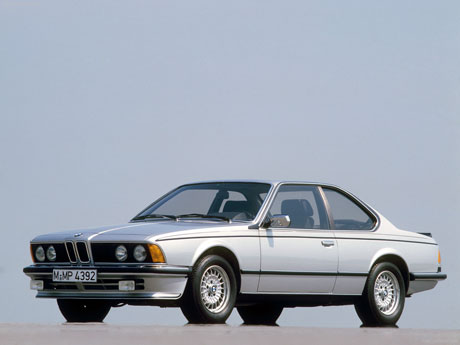
Although it's hard to believe today, BMW nearly didn't survive the late 1950s and 1960s. Thirsty and expensive Baroque sedans, the hard-to-find V8-powered 507 sports car (253 built), and the tiny egg-shaped Isetta wasn't really a formula for success.
The "New Class" 1,500-cc sedans of 1962, which led directly to the 2002 and a successful series of 2,500-, 2,800-, and 3,000-cc sedans and coupes, changed that, in rapid succession. Perhaps the crown jewel of BMW's renaissance was the E9 coupe-better known as the 2800 and 3.0CS.
Though lovely to look at, it was a hideously rust-prone pillarless coupe and was ultimately unable to meet what everyone thought were going to be rather stringent 1977 federal roll-over standards. In any event, both the E9 coupe and the sedans that shared its underpinnings were looking decidedly long in the tooth by the mid-1970s. The 6 and 7 Series (coupes and sedans, respectively) would replace the 3.0CS coupe and 3.0S/Bavaria sedans in the U.S. in 1977.
Paul Bracq designed the TGV train
After a stint with Mercedes and then one in France designing the TGV train, Paul Bracq came to BMW and penned the 6 and 7 Series cars known internally as the E24 and E23. While not nearly as lovely as the Hofmeister-designed E9, the E24 Sixer was nonetheless a very handsome and successful design with greater safety built in from a stronger roof and more generous front and rear overhangs. The original E23 7 Series looked very much like a four-door version of the coupe. In the U.S., the initial versions were known as the 630CSi and the 730i.
Unfortunately, both cars debuted at a truly horrendous time for internal combustion vehicles in the U.S. The approach to emission controls on both cars was particularly ham-fisted. Low-compression heads with air injection, exhaust gas recirculation (EGR), and thermal reactors meant that the horsepower of U.S. versions was a shadow of the European cars. Worse, the amount of heat generated by the EGR and thermal reactors meant that cylinder head cracks and warping were common. For this reason alone, the 1977-79 630i/633i and 730i/733i cars should be of little interest to anyone.
A miraculous invention the size of a spark plug
In 1980, the Bosch oxygen sensor-a miraculous invention about the size of a spark plug-coupled with the catalytic converter, saved the 633CSi and 733i in America. Gone were the dreaded thermal reactors and the blast furnace-like heat they created. From 1980 on, BMW could set about creating the car the E24 should have been in the first place.
The first significant improvement was the change from Bosch L-Jetronic injection to Motronic in 1983. The Motronic box controlled not just the mixture but timing as well and allowed for greater efficiency. The last of the 3.2-liter 633CSi/733i cars also got a very nice optional Getrag 5-speed box in 1984.
The definitive versions of the E24 coupe and E23 sedan were the 3.5-liter 635CSi/735i of 1985-89. In addition to some extra displacement, the coupe gained a front air dam and more standard features. One unwelcome addition (particularly for a buyer today) was BMW's flirtation with Michelin TRX tires, fitting only a 390-mm wheel rather than a conventional 14- or 15-inch wheel. Tire technology has rendered the TRX obsolete. The only alternative to buying replacement TRXs at great cost on the specialty tire market is to fit 14- to 16-inch wheels.
Both cars were offered briefly as the L6 and L7, with a few additional luxury features standard, but the ultimate 6 Series was clearly the M6 coupe of 1988-89. Offered only with a 5-speed and a 256-hp engine, the $60,000 M6 restored some sorely needed credibility to BMW's late 1980s offerings. Only 5,803 were sold, and they're rare today. SCM estimates values at $14k-$18k, but none has come to auction recently. Factory hot rod Alpina coupes were made in such small numbers that it's a seller's market. Just make sure you get complete provenance.
Although not particularly troublesome cars, the most recent E24 coupes and E23 sedans are now over 20 years old. Things like Motronic boxes, ABS pumps, sensors and dash wiring, switches, and motors all fail eventually-with expensive consequences. BMW's notoriously bad rust-proofing improved considerably in the 3.5-liter cars, but you should still be on your guard. Interiors on hot-climate cars also come undone with age, with leather shrinking and plastic cracking.
Bad, cheap 6s and 7s abound on Craigslist, and just as with cheap Ferraris, these wind up being the most expensive cars to own once fixed. Only the best of the best are worth considering. And even these are still quite cheap. The nicest 6 I've ever seen was one in St. Louis that was on eBay. I was checking it out for SCMer Steve Haas. A 60,000-mile airline pilot's car, it was nearly perfect in every way. Just as I was giving Haas the thumbs up, another lucky individual hit the "Buy it Now" button for $8,500.
As collectibles, it's doubtful these lovely cars will see any serious appreciation anytime soon, although the M6 is probably the best bet. Still, they seem to have made the transition from used car to a minor collectible at this point; they no longer make the socio-economic statement "couldn't afford a new BMW coupe" and now stand as a testament to the owner's discerning good taste and economic stability.
